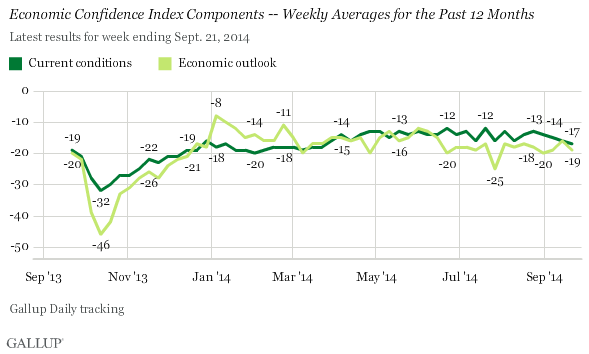WASHINGTON, D.C. -- Gallup's U.S. Economic Confidence Index slipped two points to -18 for the week ending Sept. 21. Though down slightly, the index remains in the narrow range it has varied within thus far in 2014.

Gallup's Economic Confidence Index is the average of two components: Americans' views of current economic conditions and their opinions on whether the economy is getting better or worse. Last week, 18% of Americans said the economy was "excellent" or "good," while 35% said the economy was "poor," resulting in a current conditions index score of -17. Over the past four weeks, the current conditions index has fallen one point per week.
Meanwhile, 38% of Americans last week said the economy was "getting better," and 57% said it was "getting worse." This resulted in an economic outlook score of -19, down three points from the week before, but similar to several prior weeks.

Bottom Line
Despite this week's two-point drop in confidence, the U.S. Economic Confidence Index is still unusually stable, compared with previous years. The index dropped precipitously during last year's federal government shutdown, but nothing this year has affected it as profoundly.
The Economic Confidence Index may be in negative territory at the moment, but this is in contrast to other measures that are currently more positive -- job creation is at a six-year high and consumer spending is up.
Survey Methods
Results for this Gallup poll are based on telephone interviews conducted Sept. 15-21, 2014, on the Gallup Daily tracking survey, with a random sample of 3,530 adults, aged 18 and older, living in all 50 U.S. states and the District of Columbia.
For results based on the total sample of national adults, the margin of sampling error is ±2 percentage points at the 95% confidence level.
Interviews are conducted with respondents on landline telephones and cellular phones, with interviews conducted in Spanish for respondents who are primarily Spanish-speaking. Each sample of national adults includes a minimum quota of 50% cellphone respondents and 50% landline respondents, with additional minimum quotas by time zone within region. Landline and cellular telephone numbers are selected using random-digit-dial methods. Landline respondents are chosen at random within each household on the basis of which member had the most recent birthday.
Samples are weighted to correct for unequal selection probability, nonresponse, and double coverage of landline and cell users in the two sampling frames. They are also weighted to match the national demographics of gender, age, race, Hispanic ethnicity, education, region, population density, and phone status (cellphone only/landline only/both, and cellphone mostly). Demographic weighting targets are based on the most recent Current Population Survey figures for the aged 18 and older U.S. population. Phone status targets are based on the most recent National Health Interview Survey. Population density targets are based on the most recent U.S. census. All reported margins of sampling error include the computed design effects for weighting.
In addition to sampling error, question wording and practical difficulties in conducting surveys can introduce error or bias into the findings of public opinion polls.
For more details on Gallup's polling methodology, visit www.gallup.com.
